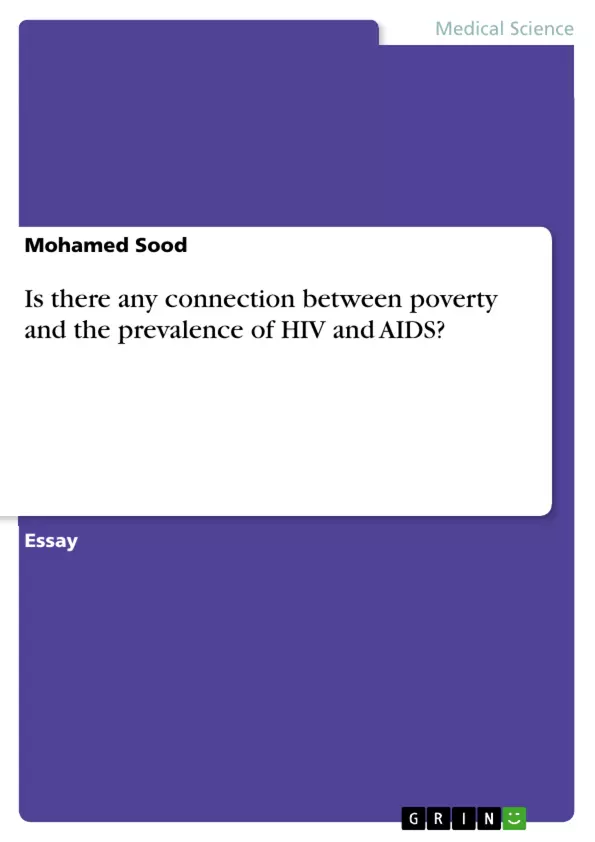The connection between poverty and HIV and it’s a marriage that needs to
be prevented.
To understand the relationship one has to make sense of the complex socioeconomic
processes in the society and not forgetting conceptualization of
poverty which is multi-dimensional. Poverty actually completes the vicious
cycle of HIV.
The estimated number of people living with HIV in 2009 was estimated to be
around 33.3 million by the United Nation Program on HIV/AIDS( UNAIDS),
in sub-Saharan Africa two thirds are infected with HIV and they are from
lower socio-economical groups, with women affected more than men(
Regional Statistic for HIV and AIDS, 2009)
High percentage of population living on less than 1 dollar per day have a
higher HIV prevalence as shown by the data provided by UNAIDS. (Global
Report, 2006) Industrialized countries have lower HIV prevalence, compared
to countries with high percentage of population living below 1 dollar. The
graph below shows the relationship between poverty and HIV.
Is there any connection between poverty and the prevalence of HIV and AIDS?
The connection between poverty and HIV and it’s a marriage that needs to be prevented.
To understand the relationship one has to make sense of the complex socio-economic processes in the society and not forgetting conceptualization of poverty which is multi-dimensional. Poverty actually completes the vicious cycle of HIV.
The estimated number of people living with HIV in 2009 was estimated to be around 33.3 million by the United Nation Program on HIV/AIDS( UNAIDS), in sub-Saharan Africa two thirds are infected with HIV and they are from lower socio-economical groups, with women affected more than men( Regional Statistic for HIV and AIDS, 2009)
High percentage of population living on less than 1 dollar per day have a higher HIV prevalence as shown by the data provided by UNAIDS. (Global Report, 2006) Industrialized countries have lower HIV prevalence, compared to countries with high percentage of population living below 1 dollar. The graph below shows the relationship between poverty and HIV.
Abbildung in dieser Leseprobe nicht enthalten
Sub-Saharan Africa is the world poorest region and it accounts for more than 60 percent of people living with HIV. People living with HIV in Sub- Sahara Africa are poor reflects that the epidemic has now spread. (Piot p, Greener R, Russell S, 2007) More than 14000 people are daily infected with HIV and 11000 are dying due to HIV/AIDS related illness in sub-Saharan Africa (World Health Organization, 2005)
Access to HIV treatment and prevention services is a challenge among poor and marginalized populations living with HIV. People infected with HIV, who receive treatment, survive on average 27.8 years instead of 11.7 years expected in the absence of treatment (United Nation Population Division, 2008 Revision).
Frequently asked questions
What is the main topic discussed in this text?
The text explores the connection between poverty and the prevalence of HIV and AIDS, particularly in sub-Saharan Africa.
What is the main argument presented?
The text argues that poverty and HIV/AIDS are interconnected, creating a vicious cycle where poverty increases vulnerability to HIV, and HIV further exacerbates poverty.
What is the estimated number of people living with HIV in 2009?
According to the United Nations Program on HIV/AIDS (UNAIDS), the estimated number of people living with HIV in 2009 was around 33.3 million.
What region is most affected by HIV/AIDS, and why?
Sub-Saharan Africa is the most affected region, accounting for over 60% of people living with HIV. This is attributed to the region's high levels of poverty.
How does poverty increase the risk of HIV transmission?
Poverty contributes to malnutrition, which weakens the immune system and increases susceptibility to sexually transmitted infections, including HIV. Poor health overall heightens the risk of infection.
What are some of the challenges faced by poor populations regarding HIV treatment and prevention?
Poor and marginalized populations often face challenges in accessing HIV treatment and prevention services.
How does HIV treatment affect life expectancy?
People living with HIV who receive treatment can expect to survive an average of 27.8 years, compared to 11.7 years without treatment.
What factors, besides poverty, contribute to increased HIV risk in impoverished populations?
Factors such as malnutrition, stress, and poor nutrition can decrease immune response in HIV-negative persons.
- Quote paper
- Dr. Mohamed Sood (Author), 2013, Is there any connection between poverty and the prevalence of HIV and AIDS?, Munich, GRIN Verlag, https://www.grin.com/document/215379



